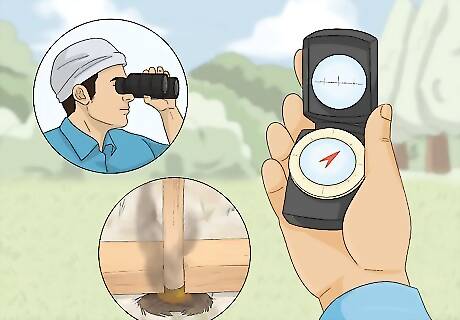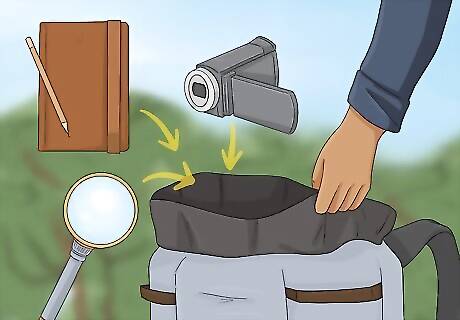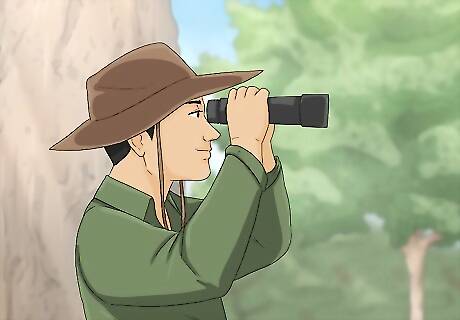
views
X
Research source
There’s no qualification or certification to become a cryptozoologist, but it’s a field filled with passionate and enthusiastic experts. We’ll tell you everything you need to know about cryptozoology, what a cryptozoologist does, how to become one, and what sort of careers you might pursue if you’re passionate about the mysterious world of hidden creatures.
- Cryptozoologists study animals and creatures that haven’t been proven to exist to help us enhance our understanding of the world around us.
- Become a cryptozoologist by conducting research into your favorite cryptid online, at a library, or by conducting your own investigation and cryptid hunt.
- Make a career in cryptozoology by writing about your experiences with cryptids, or study biology, zoology, or anthropology to put your skills to use.
What is cryptozoology?

Cryptozoology is the study of undiscovered or mythical creatures. Cryptozoologists study creatures that aren’t proven to exist, and which aren’t recognized by traditional science. That includes creatures like the Loch Ness monster, Bigfoot, Mothman, and other mythical beings or animals of folklore. These creatures are often called “cryptids.” Cryptozoologists often attempt to prove the existence of these creatures, or study how they might live and function if they did happen to be real. Many people regard Anthonie Cornelis Oudemans, who researched various sea monsters, as the first true cryptid scholar. But it was Bernard Heuvelmans, a Belgian-French scientist, who coined the term “cryptozoology” in 1995, and argued for its value as a real scientific field.

Cryptozoology is more of a passion or a hobby than a career. Unlike more traditional careers like zoologists or biologists, you probably won’t find a job listing or “help wanted” ad for a cryptozoologist. But that doesn’t mean you shouldn’t pursue your passions! Just because “traditional science” doesn’t pay much attention to cryptids doesn’t mean they’re not worthy of our time. By investigating the unknown, cryptozoologists help to make many other discoveries that might not have been made otherwise. Many animals that are well-known today were only rumors until they were investigated by scientists, like the komodo dragon, platypus, and the okapi. Often, cryptozoology overlaps with more traditional fields, like biology and zoology, and also history, anthropology, archeology, and others. In this way, cryptozoology can be a powerful gateway to other career paths.
Studying to Be a Cryptozoologist

Research your favorite cryptids at home. Being a cryptozoologist doesn’t require any sort of degree or special license. It’s mostly a field of self-taught enthusiasts, so you can dive right in at home. To start, pick a cryptid that really fascinates you. Then, conduct research into that cryptid to find out what people might already know about it. Head to your library and ask the librarian if they have any books on the cryptid, or head to a site like Western Washington University Cryptids to find a starting point. You might also listen to cryptozoology podcasts like Camp Monsters, or watch cryptozoology YouTube channels like Crash Course Cryptozoology.

Earn a degree in a related field to learn more about animals. It makes sense the cryptozoology is related to zoology—it’s right there in the word! So if you want to level up your cryptozoology know-how, consider becoming a biologist or zoologist. Plenty of educated biologists investigate animals that aren’t proven to exist. Their knowledge of everyday animals helps them to imagine how an undiscovered animal might act, which is a big help in cryptozoology. If you’re interested in an aquatic cryptid like the Loch Ness monster, you might study marine biology. Interested in a cryptid that flies through the air like Mothman? Ornithology, or the study of birds, could help deepen your understanding.

Study anthropology or folklore to learn about cultural beliefs. Many cryptids are rooted in the mythology and folktales of cultures all across the world, like the vampiric Chupacabra of Puerto Rico. In order to study these kinds of cryptids rooted in folklore, it helps to learn about the cultures they came from, which in turn helps explain where and how those stories got started. Studying anthropology, mythology, history, or similar fields helps you get a more cultural view of cryptozoology.

Study practical survival skills for when you hunt for cryptids. Many cryptozoologists spend most of their time in the books, but others prefer to get their hands dirty by going out into the field. If that second one sounds like you, it’s a good idea to learn how to survive in the wild. If you’re going to be hunting cryptids in person, you’ll need to know how to perform first aid, find water, and, of course, how to track animals. To get more hands-on experience, contact your local community college, learning center, or outdoors group and ask if they have any outdoors classes available.
Researching & Hunting for Cryptids

Read about local folklore and field reports by other cryptozoologists. Once you have decided to focus on a particular cryptid, do as much research as you can on the creature, since other cryptozoologists have most likely already done work on the subject. Start by reading field reports, books, and studies done on the cryptid. Find books in your local library about the cryptid, or search for information online. A site like the USC Libraries Cryptids page is a great place to start. Look into any local folklore surrounding the cryptid, so be sure to study up on any local myths or legends that might offer clues, like where it lives, what it eats, what time of day it appears, and so on. Also, pay attention to what scientists say about the cryptid. Listening to and considering the perspectives of both skeptics and believers is key to being a good cryptozoologist.

Study the geography and culture of the area. If you’re going to find Bigfoot, you’ll need some good hiking boots. Many cryptids are said to adapt to their environments, so look up the geography of the area to learn more about the cryptid’s surroundings and get a good idea for how to prepare. Then, look up any nearby towns. Many towns offer plenty of information about local cryptids to tourists, like Whitehall, New York, which advertises its numerous bigfoot sightings. For example, if you are going after the Loch Ness Monster, look into the geographical features of the Loch Ness area, such as the Great Glen Fault and the River Ness.

Plan your travel and pack for the expedition. If your cryptid lives in another part of the world, you’ll have to plan a trip to that area in order to hunt for it. And if you plan to look for it yourself, you’ll need to pack basic expedition gear, like a tent, sleeping bag, and food. What you need may vary based on where you’re traveling and which cryptid you are looking for. In general, you will typically need: Camera and recording equipment Audio recorder Sterile collecting bottles, vials, and bags Markers to label samples Ruler and/or measuring tape Magnifying glass Logbook or journal Travel can be expensive. If you’re a novice, consider traveling somewhere nearby to hunt for local cryptids, rather than globetrotting.

Talk to locals and possible witnesses about their experiences. If you’re heading somewhere known for cryptid activity, chances are there are plenty of people with lots of experience and opinions on the cryptid in nearby towns. Ask local librarians, park rangers, police officers, town officials, and historians. These eyewitness accounts can give you clues about how to find the cryptid. Some questions you might want to ask include: “What can you tell me about the local cryptid sightings?”; “Have you seen a cryptid yourself? If so, where?”; and, “How does one find a cryptid?” If you are about to head out into the wilderness or if you are in an unfamiliar part of the world, consider hiring a local guide.

Collect evidence in the field like photographs or audio samples. The goal of every good cryptozoologist is to perform fieldwork and collect evidence of a cryptid. Fieldwork is the process of collecting evidence while out in the areas where the cryptid lives, and includes taking samples, recording audio and video, and tracking footprints. If you’re lucky, you may just catch your cryptid on camera! Take pictures of everything. If the creature is shy, set up a camera with an automatic timer and leave the area for a while. If you find feces, bone, or hair, use tweezers to place the sample in a bag. Label each bag with what it is, when you collected it, and where you found it. If you find a footprint, measure it with a ruler or tape measure. Take a picture of the footprint with the ruler beside it. Write everything down. Keep a log book of everything that you do, see, hear, and find. Be as detailed as possible.

Share your work online, or in a book or a journal. Some cryptozoologists write books detailing their travels, investigations, and findings. You might also start a blog where you write and publish your experience, or share your work in vlog form on platforms like YouTube. Or, for a more personal experience, post your findings to discussion boards like Reddit or other cryptozoology forums to share your work with a dedicated community. If your work is especially thorough and scientific, type up a research paper with your evidence and submit it to the Journal of Cryptozoology to publish your work in a more academic setting. Search online to see if there is a cryptozoological association in your local area. If there is not, you might try starting one yourself.
Careers for Cryptozoologists

Writer Cryptozoology is all about researching and compiling information, and documenting your own experiences in the field. To share those experiences, you’ll probably be writing quite a bit anyway, so a career as a writer could be a fitting path. There are already a number of cryptozoologists publishing books about their investigations, like J.W. Ocker, who writes about cryptids and other strange creatures. Or, you might become a journalist and write articles about cryptid activity in your area or around the world for a local newspaper, newsletter, or other publication. Writing about cryptozoology is often a side gig that earns you a little money on top of a more full-time job.

Museum curator There are a number of cryptozoology museums all around the world. For example, the International Cryptozoology Museum in Portland, Maine is one of the more notable organizations, sharing the world of cryptids with the general public. They’re usually smaller, more humble operations, but even so, someone has to curate their exhibits and educate visitors. Or, if you have a degree in a subject like biology or zoology, you might use your animal expertise in a zoo or larger museum, while still participating in your cryptid passion on the side. Most cryptozoology museum curators work part-time for hourly pay.

Wildlife biologist Wildlife biologists observe wild animals to study their behaviors in order to enhance our understanding of the wild world around us. They spend a lot of time traveling and exploring the outdoors, and do research in labs. Sounds like things cryptozoologists do! Becoming a wildlife biologist is a great way to foster skills and know-how that’ll translate to a passion for cryptozoology. And who knows, you might just discover an exciting new creature. Most wildlife biology positions require at least a bachelor’s degree in biology, zoology, or a related subject, and make an average of $66,000 a year.

Cultural anthropologist Anthropologists study how humans interact with each other and their environments, to better understand how different cultures function and exist. Cryptozoologists, too, tend to learn about various cultures as they research cryptids rooted in certain beliefs and folklore. Becoming a cultural anthropologist can help you learn how to study humans and the stories they tell, which can help you tremendously in your cryptozoology studies. Most universities offer bachelor’s degrees in various anthropology fields, with opportunities for higher degrees like masters’ or even PhDs. Anthropologists often earn around $64,000 a year.




















Comments
0 comment